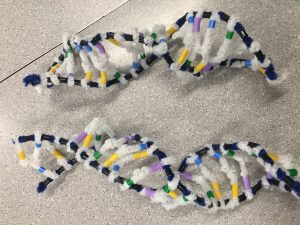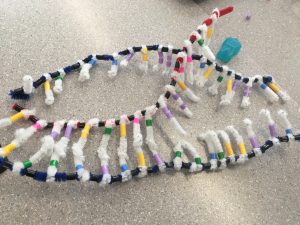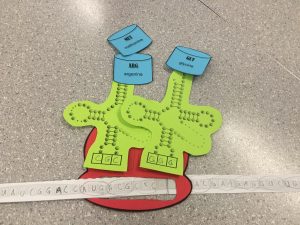Storybook link here.
Javascript Breakout Game
Diffusion in Agar Cubes
The most effective size cube was the 1 cm cube.
Since it is the smallest cube, there is less volume for the base to travel through. Surface area, temperature, and concentration are important factors that affect the rate of diffusion.
Large surface area is helpful towards diffusion, but increased volume is not. The larger the volume, the slower the rate of diffusion will be.
Bacteria are single celled, and cells only grow up to a certain size. Fish are multi cellular and contain many cells, so they can grow to a much larger size.
DNA and Protein Synthesis
DNA has an alpha helix shape. It consists of nucleotides which are made from pentose, phosphate, and a nitrogenous base. There’s two types of bases: Purines and pyrimidines. Purines have a double ring structure, and contain adenine and guanine. Pyrimidines have a single ring structure, and contain thymine and cytosine. These nucleotides connect with each other to create the double helix shape that DNA has. There is a complimentary base pairing between nucleotides: Adenine bonds with thymine and guanine bonds with cytosine. They are also antiparallel.
It clearly shows how the complimentary base pairs bond together and how the structure of a single nucleotide looks like. After twisting the model, the shape of the DNA is well represented, as the way the DNA twists into a helix is clearly shown. However, the structure of the backbone is a little confusing to understand, from the model. There are beads for phosphates but not for the sugars. If there were also beads for the sugars, it would be easier to show the antiparallel structure of the strands.
Replication
DNA replication begins when the cell recognizes that it’s become too big. It happens just before mitosis, so that the cell can split into two.
The three steps of DNA replication are unwinding, complimentary base pairing, and joining. Unwinding is the first step: The helix untwists, as H-bonds are broken. The helicase enzyme causes these bonds to break.
The next step is complimentary base pairing. Nucleotides pair up with their respective partners: Adenine bonds with thymine, and guanine bonds with cytosine. Polymerase assists with this process.
The final step is joining. A covalent bond between the phosphates and sugars are formed, forming a new strand of DNA. It then twists into the double helix shape. Polymerase reads the DNA strand from 3′ to 5′. The leading strand is the one with the extra sugar at the front. Since polymerase reads DNA in that direction, the lagging strand is read backwards, in sections. The enzyme ligase joins these fragments back together.
Seeing the distinction between each step was made clear with the models. Using different candies to represent the enzymes also showed how each one plays a role within each step. However, it was hard to understand from the model which end was the 3′ end and which was the 5′. The unzipping of the lagging strand was also difficult to clearly model. Since the backbone of the DNA strands were all blue, it is also difficult to show how one strand from the parent DNA gets used to create the daughter strand.
Transcription
mRNA is much, much smaller than DNA. It is one sided and the size of one gene on a DNA strand, allowing it the ability to move in and out of the nucleus. This way, the protein making instructions can be carried out, even though the DNA stays within the nucleus of the cell. DNA has one strand, called the “sense” strand. This contains the instructions for protein synthesis. The other stand, the “nonsense” strand, does not actually contain real instructions, so mRNA must copy the sense strand to carry out transcription.
A strand of information from DNA is copied to a mRNA strand. Like replication, there are three main steps:
- Unwinding
- Complimentary base pairing
- Separation
The DNA untwists with the help of RNA polymerase, which is an enzyme that assists with all three steps. mRNA nucleotides are joined together that are complimentary to the DNA sense strand.
Once copied, the mRNA strand exits the nucleus through nuclear pores and the DNA returns to its original state.
Each of the steps was shown very clearly. With the model, it is easy to visualize what the process looks like, and how it functions. The challenge with this model was showing the mRNA copying the strand of the DNA. The pipe cleaners were unorganized and hard to work with, so this step look confusing. Since our DNA strands were only 1 gene long, the model also does not really show how the size of DNA differs from mRNA.
Translation

In initiation, the ribosome holds the mRNA and reads the first codon (AUG) in the P-site. tRNA has anticodons that are complimentary to the codons on mRNA.
In elongation, the ribosome moves down the mRNA in the 5’ to 3’ direction, and tRNA brings the correct amino acids according to the sequence of codons on the mRNA. The next codon is read in the A – site, and the chain of amino acids in the P – site is transferred to the tRNA in the A – site.
The final step of translation is termination. When the ribosome reads a stop codon (UAG, UGA, UAA), there is no complimentary pair, so the process is ended. The ribosome releases the mRNA, tRNA, and the new protein.
The structure of the ribosome and how it reads mRNA was well represented. With the slot cut out in the ribosome, it was easy to shift the ribosome to the right as it read the codons. The model does not show the release factor and how the polypeptide chain is separated with water.
Winter
Winter blossoms into my soul,
And keeps me encased in a flurry of gold.
The seed of merriment and joy,
Cultivates in the palm of our hearts.
What is winter?
It is a song of silence,
Slowly spreading its lyric across the landscape.
It is the sweet aroma of coffee,
Enveloping the morning with a warm hug.
It is the dawn of a new life,
Awaiting to bloom from a deep sleep.
Notebooks
Link to the article is here.
Recently, I began free writing in my notebook whenever procrastination came around, to motivate myself to continue studying. When I read Didion’s article on notebooks, I found myself relating to her in a lot of ways. I write spontaneous notes inconsistently as well, some entries years apart from each other. I really loved the way she used imagery and language in her article. Her detailed descriptions helped me visualize the memories she was remembering: “We were on her terrace by the sea, and we were finishing the wine left from lunch, trying to get what sun there was, a California winter sun.” (Didion 5) Didion revealed the importance of keeping a notebook, and why “preserving everything observed” has value within it. (Didion 3) We often notice when others around us change, especially loved ones. But to notice that change within ourselves is difficult. When I read my entries from 2012, it seemed like I was reading someone else’s notebook. I felt a little disturbed because that carefree person who wrote about her gelato filled summer vacation had smooth, neat printing laced with a witty sense of humor; a huge contrast with the recent scribbles on existentialism and egalitarianism. Years will fly by, and before we know it, we will have aged into a completely different person. Keeping a notebook enables us to stay in contact with not just our past selves, but reality as well.
The Quest to Success
This article first caught my attention when I saw it under the “video games” category. They have always been a very important part of my life; gaming has formed some of my most precious memories from childhood, and has always offered me a reason to keep going when things got tough. This article is the most ingenious, eloquent piece of literature I have ever read before. Not only does it evoke a lot of emotion from the connections I formed with the author’s experience with gaming, but it also cleverly strings together diverse events, films, examples, and personal memories to create a work of art. After much speculation, I reached a conclusion: The article itself is like a game of Tetris; the paragraphs are like blocks that seem to have no meaning individually, but once the reader connects the dots and fits them together, a clear picture is formed. There is no clear hint as to what the article is trying to address, as it’s been designed to leave that conclusion up to the reader, but I personally believe it is criticizing the concept of gaming. Video games are unhealthy to an extent, but that is not solely what the article is about – rather, it is that mindset, that mindset that we have when there is a challenge before us. Instead of relishing in the struggle to work through levels to beat the final boss, we would rather take shortcuts and cheat to win the game. But once we win the game, what next? There is no point anymore. We do not feel so mighty anymore, even though we beat the game; all that is left is a feeling of emptiness. Due to the Tetris effect, the lines between reality and the virtual world blur, and our lives are nothing more than a game to beat. There is no room for connections with NPCS or exciting side quests to do for the sake of adventure; just objectives and achievements to reach.
Humor
Humor is a strained silence filled with bodies shaking of laughter.
Feels like a sharp slap on the knee, the punch line hitting it’s mark.
Tastes like a pomegranate, juice exploding out of nothingness.
Looks like flames leaping into the hearth, warming our hearts.
Humor smells like an intoxicating perfume, dizziness infecting our consciousness.
Egalitarianism or Competition?
Link to the article is here.
This article caught my interest the moment I read the title. Anything providing insight on our education system is worth the read, as almost every single person I have questioned have all agreed – it is flawed and needs to be improved. The author argues that teachers are not pushing their students hard enough, and that there is too much of an emphasis on playing nice in order to preserve the student’s feelings and confidence. I am in agreement. When I compare my elementary and middle school teachers to my high school teachers, they certainly encouraged us to challenge ourselves more back then. However, it is not only egalitarianism that contributes to fewer entrepreneurs and innovative students. Our advance in technology has made us dependent on Google, and we no longer read as much as a society. We have become accustomed to receiving instantaneous results, rather than persevering through failure to reach our goals. While I do agree teachers should increase competition and challenge their students more, they must do it in moderation. There is a limit. In South Korea and China, it is not uncommon for many students to commit suicide because of pressure and stress from their teachers and parents.
This author uses very rich vocabulary, and their sentences are very concise: “As a result, the ripple effect of this will undoubtedly instill some level of healthy competition among burgeoning innovative Canadians” (Lacavera). Their style works well to convey their message, as the issue they are addressing is serious.
Hope From Innocence
Link to essay here.
Kate Hutton highlights the potential young people possess, and reflects on her experience as an English 10 teacher. She mentions reading To Kill a Mockingbird with her students, which was a memorable experience for my Grade 10 year. Not only did this connection catch my attention, but also her writing style. She utilized rhetorical questions and her tone changed from humorous to serious, creating a contrast between the beginning and end of the essay: “…the course that I teach – English 10 – should be re-titled ‘Doom and Gloom Literature.’” Hutton explains that as we age, our hearts become “hardened” and we grow to be ignorant towards all the injustice occurring in the world. Growing up, I have always noticed this within many of my older friends. These observations led me to reach the same conclusion as Hutton: We should shed the barriers around our hearts and remain hopeful for the future, in order to make the world a better place.


















